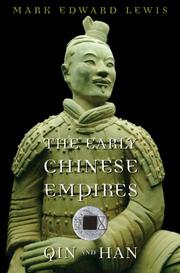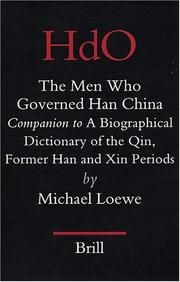| Listing 1 - 10 of 14 | << page >> |
Sort by
|
Book
ISBN: 9787101020465 7101020461 Year: 1998 Publisher: 北京 中華書局
Abstract | Keywords | Export | Availability | Bookmark
 Loading...
Loading...Choose an application
- Reference Manager
- EndNote
- RefWorks (Direct export to RefWorks)
Book
ISBN: 3447033843 Year: 1993 Publisher: Wiesbaden Harrassowitz
Abstract | Keywords | Export | Availability | Bookmark
 Loading...
Loading...Choose an application
- Reference Manager
- EndNote
- RefWorks (Direct export to RefWorks)
S06/0202 --- S02/0210 --- S14/0300 --- Chinese classics --- -Chinese classics --- -Chinese literature --- China: Politics and government--Government and political institutions: Han - 589 --- China: General works--Intellectuals: general and before 1840 --- China: Education--History of traditional education (incl. examination system) --- Criticism, Textual --- History and criticism --- Political aspects --- Chinese literature --- Criticism, Textual. --- History and criticism. --- Political aspects. --- -China: Politics and government--Government and political institutions: Han - 589
Book
ISBN: 9780295742601 9780295742397 9780295742403 0295742402 Year: 2018 Publisher: Seattle : University of Washington Press
Abstract | Keywords | Export | Availability | Bookmark
 Loading...
Loading...Choose an application
- Reference Manager
- EndNote
- RefWorks (Direct export to RefWorks)
Forming the Early Chinese Court builds on new directions in comparative studies of royal courts in the ancient world to present a pioneering study of early Chinese court culture. Rejecting divides between literary, political, and administrative texts, Luke Habberstad examines sources from the Qin, Western Han, and Xin periods (221 BCE-23 CE) for insights into court society and ritual, rank, the development of the bureaucracy, and the role of the emperor. These diverse sources show that a large, but not necessarily cohesive, body of courtiers drove the consolidation, distribution, and representation of power in court institutions. Forming the Early Chinese Court encourages us to see China's imperial unification as a surprisingly idiosyncratic process that allowed different actors to stake claims in a world of increasing population, wealth, and power.
Courts and courtiers --- S06/0201 --- S06/0202 --- Court and courtiers --- Courtiers --- Kings and rulers --- Manners and customs --- Favorites, Royal --- Queens --- History --- China: Politics and government--Government and political institutions: pre-Han --- China: Politics and government--Government and political institutions: Han - 589 --- China --- Social life and customs

ISBN: 9780674057340 0674057341 9780674024779 067402477X 0674040147 0674265424 Year: 2007 Publisher: Cambridge, Mass. : Belknap Press of Harvard University Press,
Abstract | Keywords | Export | Availability | Bookmark
 Loading...
Loading...Choose an application
- Reference Manager
- EndNote
- RefWorks (Direct export to RefWorks)
In 221 B.C. the First Emperor of Qin unified what would become the heart of a Chinese empire whose major features would endure for two millennia. In the first of a six-volume series on the history of imperial China, Lewis highlights the key challenges facing the court officials and scholars who set about governing an empire of such scale and diversity.
China --- History --- History. --- anno 100-199 --- anno 1-99 --- S04/0500 --- S04/0520 --- S06/0202 --- China: History--Ancient (Pre-Han and Han, incl. Sima Qian) --- China: History--Han: 206 B.C. - 220 A.D. --- China: Politics and government--Government and political institutions: Han - 589 --- Ancient history --- History of Asia --- Chine --- Histoire --- China: History--Han: 206 B.C. - 220 A.D --- China - History - Qin dynasty, 221-207 B.C. --- China - History - Han dynasty, 202 B.C.-220 A.D.
Book
ISBN: 9789004292833 9789004300224 9789004300231 9789004300538 9004300538 9004292837 9004300228 9004300236 Year: 2015 Volume: 126 Publisher: Leiden ; Boston : Brill,
Abstract | Keywords | Export | Availability | Bookmark
 Loading...
Loading...Choose an application
- Reference Manager
- EndNote
- RefWorks (Direct export to RefWorks)
Law, State, and Society in Early Imperial China has been accorded Honorable Mention status in the 2017 Patrick D. Hanan Prize (China and Inner Asia Council (CIAC) of the Association for Asian Studies) for Translation competition. In Law, State, and Society in Early Imperial China , Anthony J. Barbieri-Low and Robin D.S. Yates offer the first detailed study and translation into English of two recently excavated, early Chinese legal texts. The Statutes and Ordinances of the Second Year consists of a selection from the long-lost laws of the early Han dynasty (206 BCE-220 CE). It includes items from twenty-seven statute collections and one ordinance. The Book of Submitted Doubtful Cases contains twenty-two legal case records, some of which have undergone literary embellishment. Taken together, the two texts contain a wealth of information about slavery, social class, ranking, the status of women and children, property, inheritance, currency, finance, labor mobilization, resource extraction, agriculture, market regulation, and administrative geography.
S06/0201 --- S06/0202 --- S08/0300 --- S11/0491 --- S04/0500 --- S17/0214 --- China: Politics and government--Government and political institutions: pre-Han --- China: Politics and government--Government and political institutions: Han - 589 --- China: Law and legislation--General works and codices: general and before 1949 --- China: Social sciences--Society before 1840 --- China: History--Ancient (Pre-Han and Han, incl. Sima Qian) --- China: Art and archaeology--Archaeology China: Pre-Han and Han --- Law --- Inscriptions, Chinese --- History --- China --- 202 B.C. - 220 A.D. --- China.
Book
ISBN: 9782251420561 2251420568 Year: 2015 Publisher: Paris : Belles lettres,
Abstract | Keywords | Export | Availability | Bookmark
 Loading...
Loading...Choose an application
- Reference Manager
- EndNote
- RefWorks (Direct export to RefWorks)
S'appuyant sur diverses sources textuelles, cette étude analyse les relations entre maîtrise de l'écriture et pouvoir qui se sont instaurées à la cour de Jiankang, en Chine du Sud, du Ve au VIe siècle. A cette époque, la première était en effet considérée comme une marque de supériorité morale, indispensable pour asseoir l'autorité du second. ©Electre 2015
Learning and scholarship --- Politics and literature --- Power (Social sciences) --- Savoir et érudition --- Politique et littérature --- Pouvoir (Sciences sociales) --- Political aspects --- History --- Aspect politique --- Histoire --- China --- Chine --- S02/0210 --- S06/0202 --- S06/0260 --- S12/0216 --- S11/0708 --- China: General works--Intellectuals: general and before 1840 --- China: Politics and government--Government and political institutions: Han - 589 --- China: Politics and government--The Chinese model --- China: Philosophy and Classics--Political philosophy --- China: Social sciences--Elite --- Chinese literature --- Political aspects. --- History and criticism --- Nanjing (Jiangsu Sheng, China) --- Politics and government. --- Politics and government --- Savoir et érudition --- Politique et littérature
Book
ISBN: 0300047673 Year: 1991 Publisher: Londres New Haven Yale University press
Abstract | Keywords | Export | Availability | Bookmark
 Loading...
Loading...Choose an application
- Reference Manager
- EndNote
- RefWorks (Direct export to RefWorks)
Sepulchral monuments --- Sculpture, Chinese --- Monuments funéraires --- Sculpture chinoise --- Political aspects --- History. --- Aspect politique --- Histoire --- S06/0436 --- S06/0202 --- S11/0708 --- S17/0214 --- -Sculpture, Chinese --- -Funeral monuments --- Funerary monuments --- Graves --- Gravestones --- Memorial tablets --- Tablets, Memorial --- Tombstones --- Monuments --- China: Politics and government--Policy towards literature and art --- China: Politics and government--Government and political institutions: Han - 589 --- China: Social sciences--Elite --- China: Art and archaeology--Archaeology China: Pre-Han and Han --- -History --- -China: Politics and government--Policy towards literature and art --- Monuments funéraires --- Funeral monuments --- Political aspects&delete& --- History

ISBN: 0521454662 Year: 1994 Volume: 48 Publisher: Cambridge ; New York, NY : Cambridge University Press,
Abstract | Keywords | Export | Availability | Bookmark
 Loading...
Loading...Choose an application
- Reference Manager
- EndNote
- RefWorks (Direct export to RefWorks)
Religion and state --- Religion et Etat --- China --- Chine --- History --- Histoire --- S06/0202 --- S13A/0450 --- S12/0216 --- S06/0250 --- -State and religion --- State, The --- China: Politics and government--Government and political institutions: Han - 589 --- China: Religion--Astrology, fortune-telling, physiognomy, occultism, numerology, divination --- China: Philosophy and Classics--Political philosophy --- China: Politics and government--Political theory: general and traditional --- Religious aspects --- -Religion and state --- -China: Politics and government--Government and political institutions: Han - 589 --- -S06/0202 --- Cina --- Kinë --- Cathay --- Chinese National Government --- Chung-kuo kuo min cheng fu --- Republic of China (1912-1949) --- Kuo min cheng fu (China : 1912-1949) --- Chung-hua min kuo (1912-1949) --- Kina (China) --- National Government (1912-1949) --- China (Republic : 1912-1949) --- People's Republic of China --- Chinese People's Republic --- Chung-hua jen min kung ho kuo --- Central People's Government of Communist China --- Chung yang jen min cheng fu --- Chung-hua chung yang jen min kung ho kuo --- Central Government of the People's Republic of China --- Zhonghua Renmin Gongheguo --- Zhong hua ren min gong he guo --- Kitaĭskai︠a︡ Narodnai︠a︡ Respublika --- Činská lidová republika --- RRT --- Republik Rakjat Tiongkok --- KNR --- Kytaĭsʹka Narodna Respublika --- Jumhūriyat al-Ṣīn al-Shaʻbīyah --- RRC --- Kitaĭ --- Kínai Népköztársaság --- Chūka Jinmin Kyōwakoku --- Erets Sin --- Sin --- Sāthāranarat Prachāchon Čhīn --- P.R. China --- PR China --- Chung-kuo --- Zhongguo --- Zhonghuaminguo (1912-1949) --- Zhong guo --- République Populaire de Chine --- República Popular China --- Catay --- VR China --- VRChina --- 中國 --- 中国 --- 中华人民共和国 --- Jhongguó --- Bu̇gu̇de Nayiramdaxu Dundadu Arad Ulus --- Bu̇gu̇de Nayiramdaqu Dumdadu Arad Ulus --- Bu̇gd Naĭramdakh Dundad Ard Uls --- Khi︠a︡tad --- Kitad --- Dumdadu Ulus --- Dumdad Uls --- Думдад Улс --- Kitajska --- Divination --- 202 av. j.-c. (dynastie des han)
Book
ISBN: 2857570244 Year: 1983 Volume: vol 15
Abstract | Keywords | Export | Availability | Bookmark
 Loading...
Loading...Choose an application
- Reference Manager
- EndNote
- RefWorks (Direct export to RefWorks)
S06/0202 --- #SML: Joseph Spae --- China: Politics and government--Government and political institutions: Han - 589 --- China --- Politics and government --- -S06/0202 --- Cina --- Kinë --- Cathay --- Chinese National Government --- Chung-kuo kuo min cheng fu --- Republic of China (1912-1949) --- Kuo min cheng fu (China : 1912-1949) --- Chung-hua min kuo (1912-1949) --- Kina (China) --- National Government (1912-1949) --- China (Republic : 1912-1949) --- People's Republic of China --- Chinese People's Republic --- Chung-hua jen min kung ho kuo --- Central People's Government of Communist China --- Chung yang jen min cheng fu --- Chung-hua chung yang jen min kung ho kuo --- Central Government of the People's Republic of China --- Zhonghua Renmin Gongheguo --- Zhong hua ren min gong he guo --- Kitaĭskai︠a︡ Narodnai︠a︡ Respublika --- Činská lidová republika --- RRT --- Republik Rakjat Tiongkok --- KNR --- Kytaĭsʹka Narodna Respublika --- Jumhūriyat al-Ṣīn al-Shaʻbīyah --- RRC --- Kitaĭ --- Kínai Népköztársaság --- Chūka Jinmin Kyōwakoku --- Erets Sin --- Sin --- Sāthāranarat Prachāchon Čhīn --- P.R. China --- PR China --- Chung-kuo --- Zhongguo --- Zhonghuaminguo (1912-1949) --- Zhong guo --- Chine --- République Populaire de Chine --- República Popular China --- Catay --- VR China --- VRChina --- 中國 --- 中国 --- 中华人民共和国 --- Jhongguó --- Bu̇gu̇de Nayiramdaxu Dundadu Arad Ulus --- Bu̇gu̇de Nayiramdaqu Dumdadu Arad Ulus --- Bu̇gd Naĭramdakh Dundad Ard Uls --- Khi︠a︡tad --- Kitad --- Dumdadu Ulus --- Dumdad Uls --- Думдад Улс --- Kitajska --- -#SML: Joseph Spae --- China. Institutionale geschiedenis. 2e-1e vr. Chr. --- Chine. Histoire politique. 2e-1e s. av. J.-Chr. --- Chine. Histoire institutionnelle. 2e-1e s. av. J.-Chr. --- China. Politieke geschiedenis. 2e-1e vr. Chr.

ISBN: 9004138455 9047413369 Year: 2004 Volume: 17 Publisher: Leiden Boston Brill
Abstract | Keywords | Export | Availability | Bookmark
 Loading...
Loading...Choose an application
- Reference Manager
- EndNote
- RefWorks (Direct export to RefWorks)
How were prominent figures in the formative stages of China’s imperial government affected by changes in the theory and practice of government and its institutions? Calling on documentary evidence, some found only recently, Dr. Loewe examines local administration, the careers of officials, military organisation, the nobilities and kingdoms, the concepts of imperial sovereignty and the part played by the emperors. Special attention is paid to the anomalies in the historical records; tabulated lists of officials and other items summarise the evidence on which the chapters are based. Historical change and intellectual controversies are seen in the growth and decay of organs of administration, in the careers of individual men and women and the personal part that they played in shaping events.
China --- Chine --- History --- Biography --- Histoire --- Biographies --- S05/0210 --- S06/0202 --- S04/0520 --- #SML: Chinese memorial library --- China: Biographies and memoirs--From ancient times until 589 --- China: Politics and government--Government and political institutions: Han - 589 --- China: History--Han: 206 B.C. - 220 A.D. --- China: History--Han: 206 B.C. - 220 A.D --- Cina --- Kinë --- Cathay --- Chinese National Government --- Chung-kuo kuo min cheng fu --- Republic of China (1912-1949) --- Kuo min cheng fu (China : 1912-1949) --- Chung-hua min kuo (1912-1949) --- Kina (China) --- National Government (1912-1949) --- China (Republic : 1912-1949) --- People's Republic of China --- Chinese People's Republic --- Chung-hua jen min kung ho kuo --- Central People's Government of Communist China --- Chung yang jen min cheng fu --- Chung-hua chung yang jen min kung ho kuo --- Central Government of the People's Republic of China --- Zhonghua Renmin Gongheguo --- Zhong hua ren min gong he guo --- Kitaĭskai︠a︡ Narodnai︠a︡ Respublika --- Činská lidová republika --- RRT --- Republik Rakjat Tiongkok --- KNR --- Kytaĭsʹka Narodna Respublika --- Jumhūriyat al-Ṣīn al-Shaʻbīyah --- RRC --- Kitaĭ --- Kínai Népköztársaság --- Chūka Jinmin Kyōwakoku --- Erets Sin --- Sin --- Sāthāranarat Prachāchon Čhīn --- P.R. China --- PR China --- Chung-kuo --- Zhongguo --- Zhonghuaminguo (1912-1949) --- Zhong guo --- République Populaire de Chine --- República Popular China --- Catay --- VR China --- VRChina --- 中國 --- 中国 --- 中华人民共和国 --- Jhongguó --- Bu̇gu̇de Nayiramdaxu Dundadu Arad Ulus --- Bu̇gu̇de Nayiramdaqu Dumdadu Arad Ulus --- Bu̇gd Naĭramdakh Dundad Ard Uls --- Khi︠a︡tad --- Kitad --- Dumdadu Ulus --- Dumdad Uls --- Думдад Улс --- Kitajska --- China (Republic : 1949- ) --- Biography. --- PRC --- P.R.C. --- BNKhAU --- БНХАУ --- Han-dynastie. --- Politieke leiding. --- Politieke elites. --- Biografische woordenboeken. --- Qindynastie.
| Listing 1 - 10 of 14 | << page >> |
Sort by
|

 Search
Search Feedback
Feedback About UniCat
About UniCat  Help
Help News
News